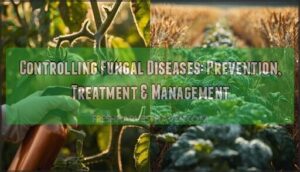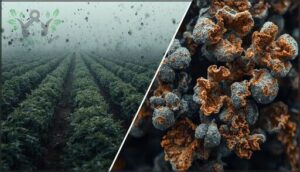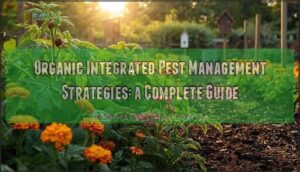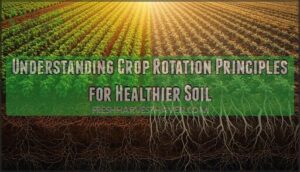This site is supported by our readers. We may earn a commission, at no cost to you, if you purchase through links.
When powdery mildew blankets 70% of your tomato leaves in a single week or rust fungi devastate an entire wheat field with 80% infection rates, you’re witnessing how quickly fungal diseases can spiral out of control. These microscopic invaders don’t just damage crops—they collapse seedlings at the soil line, trigger plant-wide lodging that ruins harvests, and cost growers billions annually in lost yields and emergency treatments.
Controlling fungal diseases requires more than reactive spraying when symptoms appear. Your success depends on understanding how pathogens spread, which prevention strategies stop infections before they start, and how to combine biological controls, resistant varieties, and targeted fungicides into a management system that protects your plants while minimizing chemical dependency and resistance risks.
Table Of Contents
- Key Takeaways
- Recognizing Common Fungal Diseases
- Prevention Through Cultural and Environmental Practices
- Biological and Alternative Control Methods
- Chemical and Advanced Technological Solutions
- Integrated Management and Monitoring Strategies
- Frequently Asked Questions (FAQs)
- How do fungal spores survive harsh winter conditions?
- Can indoor houseplants develop serious fungal infections?
- What weather patterns increase fungal disease outbreaks?
- Are organic fungicides as effective as synthetic ones?
- How long should quarantine infected plants last?
- What are the main causes of antifungal resistance?
- How do fungal diseases spread between different crops?
- Which medical conditions increase fungal infection risk most?
- What role does climate change play in fungal outbreaks?
- How effective are organic treatments versus synthetic fungicides?
- Conclusion
Key Takeaways
- Fungal diseases spread rapidly under favorable conditions like high humidity and poor air circulation, with some pathogens achieving 70-100% infection rates within days, making early recognition of symptoms like powdery mildew, rust pustules, and damping-off critical for effective intervention.
- Prevention through cultural practices—including disease-resistant plant selection, proper watering timing (4-8 AM with drip irrigation), enhanced air circulation, and rigorous sanitation protocols—can reduce fungal disease incidence by up to 70% without relying on chemical treatments.
- Biological control methods using beneficial microorganisms like Trichoderma and Bacillus subtilis achieve 70-100% pathogen suppression rates, while the biofungicide market is projected to grow from $2.3 billion in 2023 to $10 billion by 2033 as growers seek sustainable alternatives.
- Integrated management combining crop rotation, resistance management through FRAC code rotation, early detection systems, and strategic fungicide application at critical growth stages protects crops while minimizing the $100-200 billion annual global losses from fungal diseases and slowing resistance development.
Recognizing Common Fungal Diseases
Recognizing fungal diseases early gives you a significant advantage in protecting your plants, crops, and even your own health. The signs aren’t always obvious at first glance, and understanding what you’re looking for makes all the difference between minor intervention and major loss.
Let’s walk through the key indicators, risk factors, and environmental conditions that signal a fungal problem is taking hold.
Symptoms of Plant Fungal Infections
Visual identification is your first line of defense against plant fungal diseases. Recognizing symptom progression helps you distinguish true plant pathogens from mimicking symptoms caused by environmental stress, strengthening disease resistance and crop protection strategies despite diagnostic challenges.
Five key fungal infection patterns you’ll encounter on affected plants:
- Powdery Mildew: White patches covering up to 70% of upper leaf surfaces within one week under humid conditions, spreading to 100% incidence by late summer.
- Rust Fungi: Brownish-orange pustules rupturing leaf surfaces, achieving 80% incidence with pustules covering 85% of tissue in severe outbreaks.
- Leaf Spot Diseases: Necrotic lesions with brown or black centers appearing 7-8 weeks after planting, potentially causing complete defoliation.
- Anthracnose: Birds-eye spots on berries and brown stalk lesions leading to lodging, reducing harvest quality and plant defense capabilities.
- Damping-Off: Seedling collapse at the soil line, causing rapid mortality in dense plantings with poor air circulation.
Susceptible plants include azalea and dogwood, but some varieties offer disease resistant cultivars.
Types of Human and Animal Fungal Diseases
While plant infections reveal themselves through visible symptoms, fungal diseases affect humans and animals through distinct pathways. Skin fungal infections like ringworm account for over 9 million annual outpatient visits in the US, while systemic fungal diseases such as candidiasis cause 55.2% of invasive infections.
Zoonotic fungal diseases, including histoplasmosis, transfer between species, and opportunistic infections increasingly threaten immunosuppressed populations. For instance, cyclosporine therapy links to 20% infection prevalence in dogs.
Early diagnosis relies on cytology for screening.
Key Risk Factors for Fungal Outbreaks
Understanding the conditions that trigger fungal disease outbreaks helps you prevent problems before they start. Climate change has shifted spore seasons earlier across the US, while high humidity drives 36.4% of fungal outbreaks in crops.
Monoculture farming increases vulnerability as pathogens adapt to uniform crops. Pathogen adaptation accelerates through antimicrobial resistance—azole fungicides have driven resistance mutations in Aspergillus fumigatus since the 1980s.
Identifying Environmental Sources
Once you’ve considered risk factors, it’s smart to pinpoint where fungi and pathogens hide. Soil reservoirs near landfills, polluted water sources, and airborne spores riding dust all shape local epidemiology.
For instance, pollution effects can boost virulent fungal spores in the air or water. Knowing these sources helps you anticipate outbreaks and adapt your prevention strategies before problems take root.
Prevention Through Cultural and Environmental Practices
The foundation of effective fungal disease control starts well before you ever reach for a treatment. Your daily gardening practices—from selecting plants to managing water and air flow—create conditions that either invite disease or help prevent it.
The following strategies give you practical, proven ways to reduce fungal problems through smart environmental management.
Disease-Resistant Plant Selection
Selecting varieties with strong disease resistance can be your first and strongest line of defense. You’ll want to focus on breeding techniques like marker-assisted selection that improve resistance durability and varietal performance, reducing your reliance on chemical interventions later.
- Genetic diversity strengthens plant immunity against evolving pathogens
- Fungus-resistant grape varieties now occupy 10.2% of Swiss vineyards
- Resistant wheat cuts fungicide needs while maintaining high yields
- Plant defense mechanisms improve through strategic breeding programs
- Disease resistance traits reduce infection prevalence up to 50%
Proper Watering and Irrigation Techniques
When you water matters just as much as how much you water. Watering timing between 4 AM and 8 AM using drip irrigation keeps foliage dry, drastically reducing plant fungal diseases and soilborne diseases. You’ll want to avoid overhead watering at night—it creates microclimate effects that favor pathogens.
Smart watering frequency and application techniques form the backbone of effective disease control and crop protection for lasting plant health.
Enhancing Air Circulation and Light
Boosting airflow around your plants cuts fungal disease incidence by up to 70%. You’ll disrupt spore dispersal and reduce leaf moisture when you space plants properly or use fans indoors.
Sunlight exposure works hand-in-hand with better indoor airflow—UV radiation inhibits fungal development while raising leaf temperatures.
Together, these strategies strengthen disease resistance and improve plant health without chemicals.
Sanitation and Tool Sterilization Methods
Think of debris cleanup as shutting the door on fungal diseases before they start. Removing crop residue cuts pathogen levels by 90% in wheat fields, while disinfecting your pruning tools with 10% bleach between cuts prevents disease spread.
For greenhouse protocols, foot baths and weed elimination around production areas keep fungal infections at bay. These soil disinfection and debris removal practices reduce your need for alternative fungicide strategies.
Biological and Alternative Control Methods
Biological control methods utilize nature’s own defenses to combat fungal diseases without relying solely on synthetic chemicals. These approaches work by introducing beneficial organisms or utilizing naturally occurring compounds that suppress pathogenic fungi while supporting plant health.
The following sections explore how you can apply these alternative strategies to protect your plants and manage disease more sustainably.
Beneficial Bacteria and Fungi Applications
Nature’s own arsenal of antagonistic microorganisms offers powerful, sustainable agriculture solutions. When you utilize microbial consortia and probiotic applications, you’re deploying proven biocontrol mechanisms:
- Lactobacillus and Bacillus species compete directly with pathogens, limiting colonization through antifungal activity
- Saccharomyces boulardii disrupts Candida virulence in biological control methods
- Mycorrhizal fungi strengthen disease resistance by triggering systemic plant immunity
- Enzyme-producing microbes degrade fungal cell walls through direct microbial control
Microbial and Botanical Fungicide Use
You’ll find tremendous success combining biological control methods with proven products. Biofungicide efficacy reaches impressive heights—Trichoderma harzianum achieves 88-100% pathogen inhibition, while Bacillus subtilis delivers 70% control efficiency against wheat powdery mildew. Market trends reflect this: biofungicides reached $2.3 billion in 2023, projected to hit $10 billion by 2033.
| Control Agent | Target Disease | Efficacy Rate | Application Method | Market Growth |
|---|---|---|---|---|
| Trichoderma strains | Soil-borne pathogens | 88-100% inhibition | Seed/soil treatment | Core biocontrol segment |
| Bacillus subtilis | Powdery mildew | 70-71% control | Foliar spray | 24% CAGR in bio-based |
| Thyme essential oil | Fusarium spp. | High (MIC-based) | Preventive coating | $2.56B by 2033 |
| Savory nanoemulsion | Cucumber powdery mildew | 54% severity reduction | Greenhouse spray | Botanical synergies |
| Lemongrass oil | Multiple pathogens | 77% incidence drop | Integrated programs | Resistance management |
Botanical fungicides like savory and lemongrass nanoemulsions reduce plant fungal diseases by 40-54% in greenhouse trials. You can integrate these microbial fungicides with chemical controls—B. subtilis remains compatible with most DMI fungicides, though you should avoid difenoconazole concentrations above 50 µg/ml. Application methods matter: foliar sprays work best for powdery mildew, while soil drenches target root pathogens.
For resistance management, rotate between microbial and botanical fungicides throughout your growing season. North American farmers already hold 70% of the fungicide market, with bio-based segments growing fastest. Start with preventive applications at disease-prone growth stages, then follow label rates precisely—underdosing accelerates resistance while overdosing wastes resources without improving control.
Role of Mycorrhizal Fungi in Disease Control
Arbuscular mycorrhizal fungi in plants offer powerful biocontrol against soil-borne pathogens through multiple mechanisms. When you inoculate with species like Claroideoglomus etunicatum, you’ll see AMF disease suppression rates reaching 58% against Fusarium—root colonization dynamics trigger defense mechanism activation while nutrient uptake enhancement maintains plant vigor.
Combined AMF and Trichoderma applications slash anthracnose to 10%, demonstrating how arbuscular mycorrhizal fungi strengthen disease resistance through both direct biocontrol pathogens effects and improved stress tolerance.
Mycoviruses and RNA Interference Strategies
Beyond mycorrhizal partnerships, you can utilize mycoviruses for disease control through induced hypovirulence—Cryphonectria hypovirus 1 cut chestnut blight virulence in field trials.
RNA interference in plants offers targeted fungal silencing by deploying double-stranded RNA that produces small interfering RNAs, downregulating pathogen virulence genes. However, some mycoviruses encode viral suppressors that disrupt RNAi mechanisms, complicating RNAi delivery strategies.
Understanding these mycovirus biocontrol and RNAi interactions optimizes control of fungal diseases.
Chemical and Advanced Technological Solutions
When prevention and biological methods aren’t enough, chemical fungicides and emerging technologies offer powerful tools to control fungal diseases. These solutions range from traditional synthetic compounds to state-of-the-art innovations like nanoparticles and drone applications.
Understanding how to select, apply, and manage these sophisticated approaches will help you protect plants while minimizing resistance and environmental impact.
Fungicide Selection and Application Timing
When managing plant fungal diseases, you’ll find that strategic chemical fungicides application hinges on understanding FRAC code rotation and resistance risk mitigation. Select products based on fungicide efficacy ratings matched to your pathogen, then time applications to critical growth stages—corn VT-R1 or wheat GS59 optimize control.
Limit high-risk single-site fungicides to two applications per season, and consider economic spray thresholds before treating, since antifungal treatments work best preventively rather than curatively.
Nanoparticle-Based Fungicide Innovations
Emerging agronanotechnology offers powerful alternatives through nanoparticle synthesis and use. Copper oxide and silver nanoparticles demonstrate enhanced antifungal activity against resistant pathogens, while delivery systems like nanoemulsions improve bioavailability.
You’ll appreciate that nano-fungicide efficacy often surpasses conventional products at lower doses, though toxicity mechanisms through reactive oxygen species warrant careful evaluation.
Green synthesis methods provide environmentally conscious options, yet environmental impact assessments remain incomplete for field-scale nanopesticide applications.
UV Light and Drone-Based Disease Management
Ultraviolet-C light provides a green alternative for plant fungal diseases, with nightly doses of 5–72 J/m² controlling powdery mildew and gray mold in greenhouse crops without phytotoxicity.
Robotic UV systems now travel autonomously through vineyards at night when spores are most vulnerable, while drone-based sensing identifies infection zones before symptoms appear.
Drone fungicide delivery at 2 gallons per acre matches ground-rig efficacy, and application parameters combining UV-C effectiveness with precision targeting advance sustainable crop protection strategies.
Resistance Management and Monitoring
When resistant strains emerge, you can’t rely on a single tactic to protect your crops or health. Mode-of-action rotation reduces selection pressure, while sensitivity monitoring tracks efficacy shifts before total failure occurs.
- Dose strategies combining maximum low-risk with minimum high-risk fungicide applications preserve control economics
- Molecular diagnostics detect resistance alleles at 1% frequency, enabling early intervention
- Surveillance networks share documented resistance cases to inform regional management adjustments
Integrated Management and Monitoring Strategies
Managing fungal diseases effectively requires you to combine multiple strategies rather than rely on any single approach. This integrated perspective allows you to address disease pressures from several angles while keeping an eye on economic realities and long-term sustainability.
The following sections outline key components of thorough disease management, from preventive field practices to surveillance systems that help you stay ahead of emerging threats.
Crop Rotation and Environmental Modification
You can think of crop rotation and tillage as a one-two punch for plant fungal diseases. Rotation sequences that alternate hosts disrupt soil microbiome communities, reducing pathogenic fungi like Macrophomina phaseolina by measurable margins.
Meanwhile, tillage effects combined with microclimate management—controlling humidity and airflow—create conditions that don’t favor infection.
These integrated strategies for crop protection boost disease resistance and plant health using green strategies rooted in ecology, not just chemistry.
Early Detection and Surveillance Systems
Remote sensing paired with weather models can spot fungal disease outbreaks days before visible symptoms appear, giving you a critical three-to-seven-day lead time for intervention.
Digital surveillance platforms now deliver SMS alerts for wheat blast and other threats, while molecular surveillance and genomic epidemiology strengthen burden estimation.
Scaling agriculture demands these early detection tools—they’re transforming fungal disease diagnosis from reactive guesswork into proactive defense.
Economic Impact and Resource Allocation
Fungal diseases cost you far more than you might expect—plant fungal diseases slash crop yield losses by 10–23% annually, translating to USD 100–200 billion globally, while the healthcare cost burden in the U.S. alone hit USD 19.4 billion.
Fungal diseases cost the global economy over $100 billion annually in crop losses alone, plus nearly $20 billion in U.S. healthcare expenses
The fungicide market growth to USD 29.3 billion by 2033 signals rising chemical fungicides dependence, yet optimized resource use through mathematical modeling shows you can achieve better disease control with targeted allocation.
The investment needs gap remains urgent—static budgets won’t address expanding fungicide resistance or declining disease resistance. Strategic resource allocation that balances chemical fungicides with integrated approaches protects both plant health and disease control outcomes.
Developing Effective Response Plans
When a fungal outbreak hits, you need a structured plan ready—not a scramble. Effective response plans integrate fungal diseases prevention with rapid action protocols.
Your plan should include:
- Incident command systems using NIMS structure for multi-agency coordination
- Surveillance systems linking early detection labs with field responders
- Control interventions addressing both healthcare transmission and agricultural sources
- Training preparedness through regular exercises on sampling and notification chains
- After-action reviews to improve protocols based on outbreak lessons
Preparedness reduces response delays and strengthens antifungal resistance management.
Frequently Asked Questions (FAQs)
How do fungal spores survive harsh winter conditions?
Like seeds tucked beneath a winter blanket, fungal spores endure freezing through exceptional cold tolerance and desiccation resistance. Many enter a protective glassy state, employing ecological strategies that promote survival until spring temperatures trigger germination.
Can indoor houseplants develop serious fungal infections?
Yes, indoor houseplants can develop serious fungal infections. Over 20,000 plant pathogens thrive indoors.
Anthracnose, root rot, and powdery mildew commonly affect your plants when conditions favor infection severity through high humidity and poor air circulation.
What weather patterns increase fungal disease outbreaks?
You’re practically battling an invisible storm when high humidity, extreme precipitation, and elevated temperature collide—climate interactions intensify plant fungal diseases, weakening disease resistance and triggering widespread plant pathogen outbreaks that devastate crops across vulnerable regions.
Are organic fungicides as effective as synthetic ones?
The answer depends on your disease pressure and conditions. Organic options like sulfur and botanical fungicides can match synthetic efficacy in low-risk settings, but intensive outbreaks often need systemic synthetics for reliable control and resistance management.
How long should quarantine infected plants last?
You should quarantine infected plants for at least two to four weeks, extending isolation until no new symptoms appear for two consecutive weeks after treatment and all fungal signs have completely resolved.
What are the main causes of antifungal resistance?
Genetic mutations, biofilm formation, subtherapeutic exposure to medications, and agricultural azole use fuel antifungal resistance exponentially.
Multidrug-resistant pathogens now spread globally, creating clinical guidance challenges that demand antimicrobial stewardship and antifungal resistance prevention strategies.
How do fungal diseases spread between different crops?
Fungal diseases spread between crops through airborne dispersal of spores, seedborne transmission via contaminated seeds, irrigation pathways carrying plant pathogens, insect vectors transporting inoculum, and climate change expanding pathogen ranges across agricultural systems.
Which medical conditions increase fungal infection risk most?
An ounce of prevention beats a pound of cure. Diabetes mellitus, HIV infection, organ transplants, leukemia risks, and chronic lung disease dramatically weaken your immune system, making opportunistic fungal infections far more likely—especially when immune deficiency goes unmanaged.
What role does climate change play in fungal outbreaks?
Climate change accelerates emerging fungal diseases by driving temperature effects that enable pathogen adaptation, alter weather patterns, expand plant pathogen ranges, and create ecosystem disruption.
These changes intensify both plant fungal diseases and human fungal infections globally.
How effective are organic treatments versus synthetic fungicides?
Treatment effectiveness varies: organic options like sulfur maintained better microbial diversity while controlling powdery mildew comparably to synthetics. Resistance development slows with biocontrol rotation.
Cost analysis shows organics require higher application rates, though environmental impact remains considerably lower.
Conclusion
A single overlooked spore can unravel months of careful cultivation, turning thriving fields into barren landscapes overnight. Yet controlling fungal diseases doesn’t require faultlessness—it demands vigilance, layered defenses, and the wisdom to act before symptoms explode.
Your commitment to integrating resistant varieties, biological allies, and precision treatments transforms vulnerability into resilience. When prevention becomes instinct and monitoring becomes routine, you’re not just protecting plants—you’re safeguarding entire growing seasons from collapse.
- https://www.mpg.de/23545750/plants-fungal-diseases
- https://pmc.ncbi.nlm.nih.gov/articles/PMC6779379/
- https://journals.asm.org/doi/10.1128/mbio.00449-20
- https://microbe-investigations.com/the-economic-impact-of-fungal-contamination-in-agriculture-and-industry/
- https://hh-ra.org/2021/05/05/fungicides-use-a-resistant-pathogen-and-rising-death-rates-cdc-connects-the-dots/












